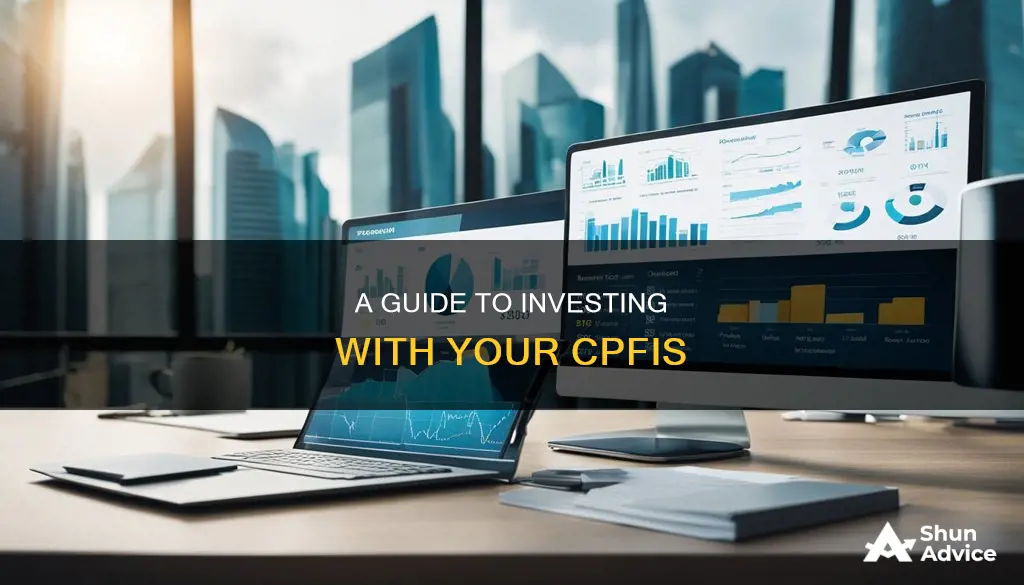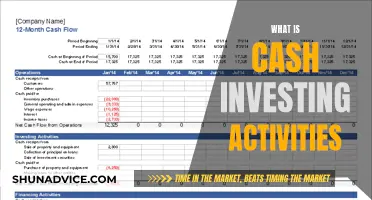
The CPF Investment Scheme (CPFIS) is a way to invest your Ordinary Account (OA) and Special Account (SA) savings to enhance your retirement savings. Anyone over 18 can invest through CPFIS as long as they have over $20,000 in their OA and/or over $40,000 in their SA. You can invest in a wide range of products, including investment-linked insurance products, Singapore Government Bonds, Exchange-Traded Funds, and Mutual Funds. However, it's important to remember that all investments come with risks and you should only invest money you can afford to lose.
| Characteristics | Values |
|---|---|
| Who can invest | Anyone over 18 who is not an undischarged bankrupt and has over $20,000 in their Ordinary Account (OA) and/or over $40,000 in their Special Account (SA) |
| Investment options | Investment-linked insurance products (ILPs), Singapore Government Bonds (SGBs), Treasury Bills (T-bills), Exchange-Traded Funds (ETFs), Fund Management Accounts, Fixed Deposits (FDs), Statutory Board Bonds, Bonds Guaranteed by the Singapore Government, stocks, gold and other gold products |
| Investment limits | Up to 35% of investible savings can be invested in stocks; up to 10% of investible savings can be invested in gold |
| Investment account | Only one CPF Investment Account can be held at any one time |
| Withdrawing investments | Investments can be withdrawn after setting aside the Full Retirement Sum (FRS) in your Retirement Account (RA) |
What You'll Learn

Understanding the risks
It is important to understand the risks of various investment options and assess how they align with your investment goals, risk tolerance, and personal circumstances. Ask yourself: What is the amount of risk I am comfortable with and can afford to take? Can I handle temporary short-term losses? Do I have enough savings to absorb the investment risks?
The potential for higher rewards often comes with greater risks. It is recommended to conduct your own research and invest in products that you understand. This allows for a deeper understanding of how your assets work and provides peace of mind when your assets are underperforming.
Additionally, consider the investment horizon. Investments promising high returns within a short period may also carry a high chance of losing your original investment. CPF savings are generally for long-term purposes unless you are nearing retirement or have a short-term investment horizon for other reasons.
When investing with CPFIS, it is crucial to look for investments that offer higher returns than CPF interest rates. However, these investments may also be riskier. CPF savings offer risk-free interest, so it is important to only invest your CPF savings if you are confident of earning more than the CPF interest.
How Stash Helps You Invest Your Cash
You may want to see also

Investment options
The CPF Investment Scheme (CPFIS) allows you to invest your Ordinary Account (OA) and Special Account (SA) savings in a wide range of investments to enhance your retirement savings. The CPF Board does not endorse any product providers or investment products included under the CPFIS. All investments come with risks, and you should only invest with money that you can afford to lose.
- Investment-linked insurance products (ILPs)
- Singapore Government Bonds (SGBs)
- Treasury Bills (T-bills)
- Exchange-Traded Funds (ETFs)
- Fund Management Accounts
- Fixed Deposits (FDs)
- Statutory Board Bonds
- Bonds Guaranteed by the Singapore Government
- Gold products (such as Gold certificates, Gold savings accounts, Physical Gold)
It is important to note that there are limits to how much you can invest in stocks and gold. You can only invest up to 35% of your investible savings in stocks and 10% in gold. Investible savings refer to the sum of your OA balance and the amount of CPF you have withdrawn for investment and education.
Before investing, it is crucial to understand the risks involved and ensure that you are making informed decisions. Conduct thorough research on the investment products and only invest what you can afford to lose.
Understanding Dividends: Cash Dividends and Their Nature
You may want to see also

How much to invest
The amount you can invest using the CPF Investment Scheme (CPFIS) depends on the type of account you have.
CPF Investment Scheme-Ordinary Account (CPFIS-OA)
You can invest your OA savings after setting aside $20,000 in your OA. In addition, you can only invest up to 35% of your investible savings in stocks and up to 10% in gold. Investible savings refer to the sum of your OA balance and the amount of CPF you've withdrawn for investment and education.
CPF Investment Scheme-Special Account (CPFIS-SA)
You can invest your SA savings after setting aside $40,000 in your SA.
You can find out how much of your OA and SA savings you can invest by logging in to my cpf digital services with your Singpass, using the CPF Mobile app, or by visiting any CPF Service Centre with your identity card.
Understanding Investment Revenue in the Cash Flow Statement
You may want to see also

Opening a CPF Investment Account
To open a CPF Investment Account, you must meet the following criteria:
- Be a Singapore Citizen or Permanent Resident
- Be 18 years old or above
- Have more than $20,000 in your CPF Ordinary Account (OA)
- Have no existing CPF Investment Account with any bank
- Have a DBS/POSB Deposit Account
- Not be an undischarged bankrupt
- Have completed the Self-Awareness Questionnaire (SAQ)
You can apply for a CPF Investment Account (CPFIA) with DBS/POSB online. Your application will be rejected if the SAQ is incomplete or contains inaccurate information. You will be notified of the status of your application via SMS or letter within 3-5 working days.
If you already have a CPF Investment Account with another bank and wish to transfer to DBS, you will need to visit a DBS branch to complete and sign the CPFIS-Inter-Bank Transfer Form and the CPFIA Account Opening Form. The inter-bank transfer process can take up to 2 weeks to complete.
It is important to note that you can only have one CPF Investment Account at any given time.
Investments, Cash Flows, and the Impact of Gains
You may want to see also

Withdrawing your CPFIS investments
You can withdraw your CPFIS-OA and CPFIS-SA investments, as well as the cash balance in your Investment Account, after setting aside the Full Retirement Sum (FRS) in your Retirement Account (RA). The FRS can be set aside fully with cash, or with cash (i.e. at least the Basic Retirement Sum) and property.
Before making a withdrawal, carefully consider if you have sufficient savings to suit your retirement lifestyle. With PayNow, withdrawn funds are deposited in your bank account almost instantly.
Making withdrawals from your CPF savings means reduced monthly payouts in the future. Alternatively, your withdrawable savings can be converted to boost your monthly payouts.
If you own a property in Singapore, with a lease that lasts you up to at least age 95, you can set aside your FRS with a mixture of property (up to half of your FRS) and cash, and withdraw part of your Retirement Account savings.
Once your withdrawal application is approved, your CPFIS investments will be transferred to you. The withdrawal will not result in the liquidation of your investment holdings.
You can make as many withdrawals as you like from your withdrawable savings. So there's no need to take everything in one go.
Your online application will generally be processed within one working day from the day your application is received.
Champagne's Investment Flows: 2008 Insights and Analysis
You may want to see also
Frequently asked questions
Anyone over the age of 18 who is not an undischarged bankrupt and has more than $20,000 in their Ordinary Account (OA) and/or more than $40,000 in their Special Account (SA).
First, assess your eligibility and complete the CPFIS Self-Awareness Questionnaire (SAQ). Then, if you wish to invest your OA savings, open a CPF Investment Account with one of the approved banks: DBS, OCBC, or UOB. You can then approach product providers directly to buy or sell investments. You do not need to open a CPF Investment Account to invest your SA savings.
You can invest in a wide range of financial products, including shares, unit trusts, government bonds, treasury bills, fixed deposits, and insurance products.
Yes, there are limits on the amount you can invest in certain products. With your Ordinary Account, you can only invest up to 35% in stocks and 10% in gold.







